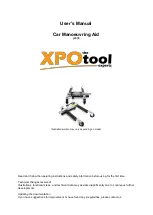
Documents are only to be used and distributed completely and unchanged. It is strictly the users´ responsibility to check
carefully the validity of this document with respect to his product. Manual-no.: 999084 / 05/10/2009
page 12 of 46
Use and operation
overpressure
safety relief
device
catchpot at
the outlet
catchpot at
the inlet
coolant outlet
(hose nozzle 6 mm)
coolant inlet
(hose nozzle 6 mm)
outlet
(gas!; hose nozzle 10 mm)
Assembly of enclosed components
Round bottom flasks:
The catchpot at the inlet prevents droplets and particles from
entering the pump.
☞
Lifetimes of diaphragms and valves are enhanced.
☞
Improves vacuum in case of condensation.
Both round bottom flasks are coated with a protective layer to
prevent disintegration in case of breakage or implosion.
➨
Assemble the catchpots at the inlet and at the outlet using
joint clips.
Exhaust waste vapour condenser:
➨
Assemble hose nozzles for coolant inlet and coolant outlet
pipelines at the exhaust waste vapour condenser.
The
exhaust waste vapour condenser
enables an efficient
condensation of the pumped vapours at the outlet.
☞
No backflow of condensates.
☞
Controlled recovery of condensates.
☞
Next to 100% solvent recovery.
☞
The isolation cover protects against glass splinters in case
of breaking, acts as thermal isolation to avoid condensation
of humidity and is intended to absorb shocks.
➨
Attach the pipelines of the coolant circuit to the respective hose nozzles (see im-
age) at the waste vapour condenser. Check hose connections prior to starting op-
eration of the cooling system.
➨
Secure coolant hoses at the hose nozzles (e.g. with hose clip) to prevent their
accidental slipping.
☞
Ensure that the
coolant outlet pipeline
is always free and that it cannot get blocked.
☞
Install an optional
coolant valve
always
only in the inlet line
of the exhaust waste
vapour condenser.
☞
The gas outlet (hose nozzle 10 mm) must not be blocked. The exhaust pipeline has
always to be free and pressureless to enable an unhindered discharge of gases.
☞
Connect the exhaust to a suitable treatment plant to prevent the discharge of dan-
gerous gases and vapours to the surrounding atmosphere.
Installing in a vacuum system:
☞
Avoid throttling losses by using connecting pipes with large diameter and keep
them as short as possible.
☞
Reduce the transmission of vibration and prevent loading due to rigid pipelines.
Insert elastic hoses or flexible elements as couplings between the pump and rigid
pipes.
Attention:
Flexible elements tend to shrink when evacuated.
☞
Use a suitable valve to isolate the pump from the vacuum system to allow the
pump to warm up before condensable vapours are pumped or to clean the pump
before it is switched off.
☞
Connect the exhaust to a suitable treatment plant to prevent the discharge of dan-
gerous gases and vapours to the surrounding atmosphere. Use a catchpot to pre-
vent the drainage of contaminated condensate back into the pump.













































